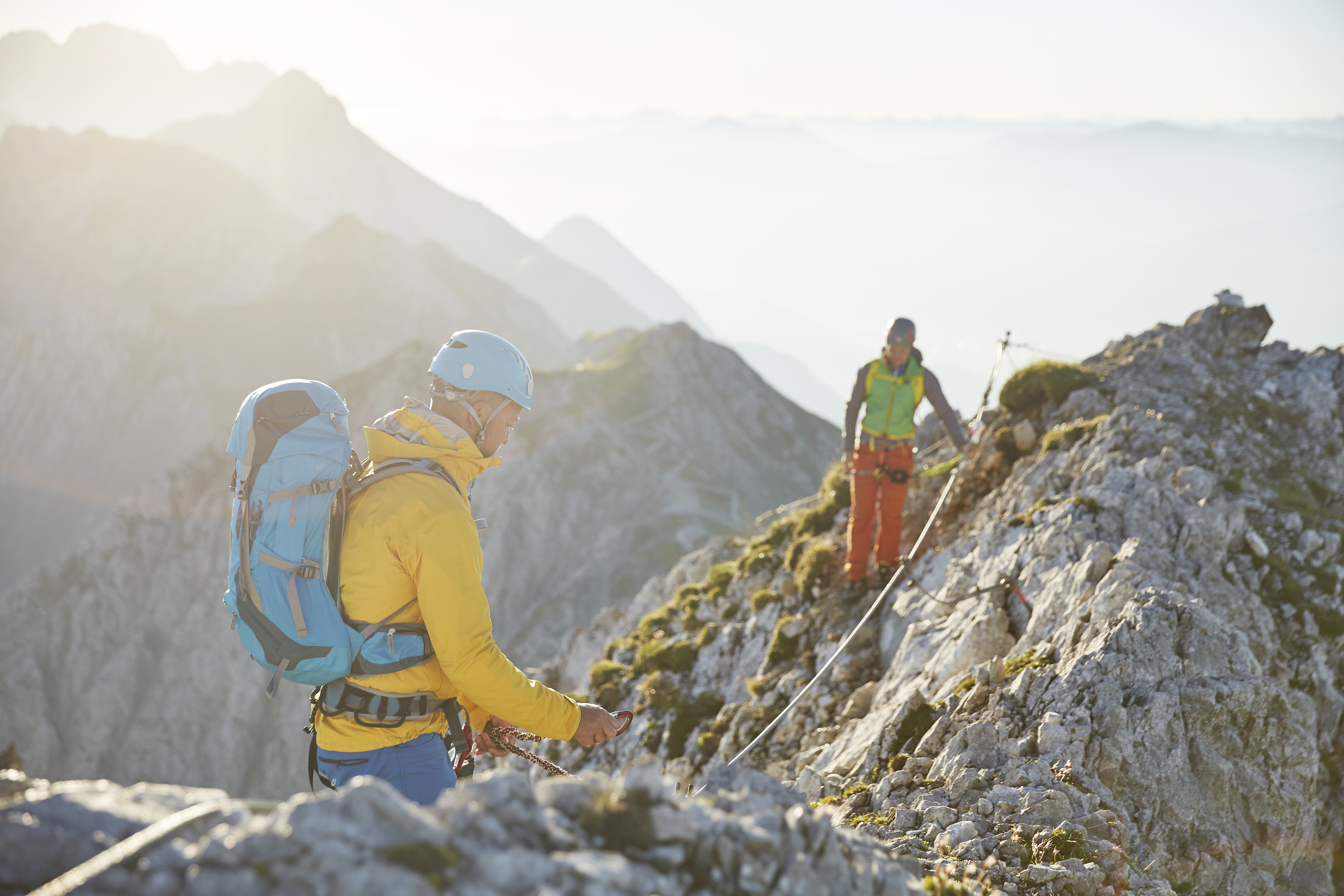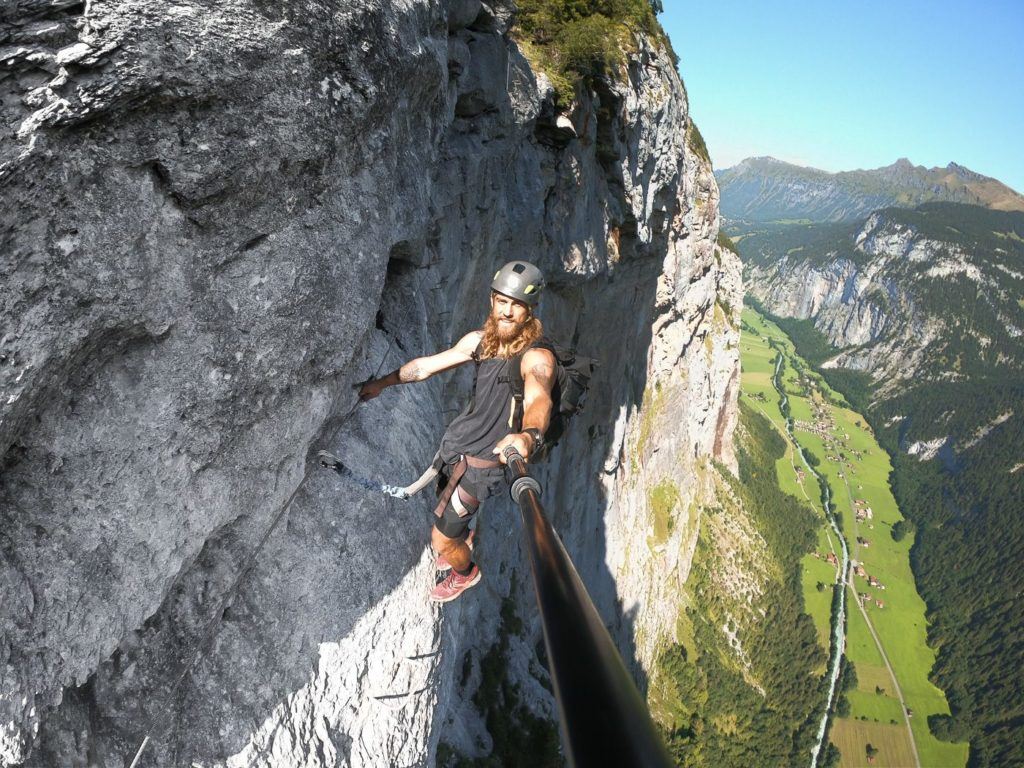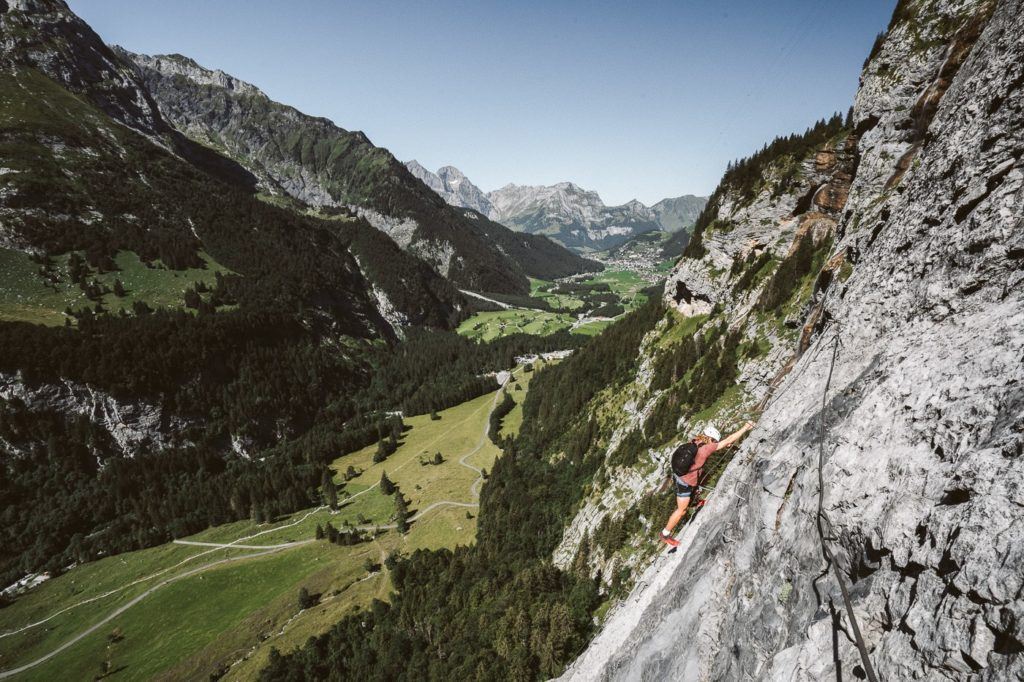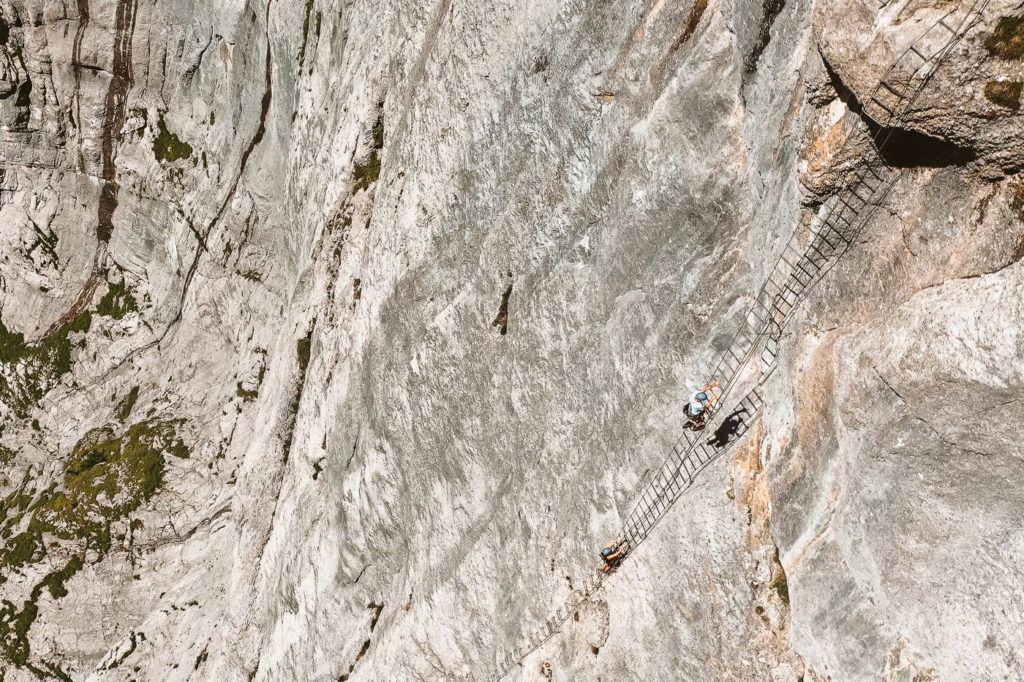Via Ferrata is one of the most epic experiences you can have in Switzerland. It’s basically a set of ladders and metal grips that lead you up the side of a mountain, often very exposed. You are attached the whole way with a harness but trust me it is still scary to hang off the edge of a cliff. In this article, I’ll share with you the Via Ferrata routes in Switzerland, which I found the most epic during my trip around the country.

4 AWESOME VIA FERRATA ROUTES IN SWITZERLAND
In this blog post, you will find a description of each of the Via Ferrata routes I did in Switzerland as well as some photos and a link to the individual blog post I wrote about all of the Via Ferrata routes. You can click on that link for a more detailed review of the Via Ferrata including maps, starting points, gera you need, how to get there, photos, directions, difficulty, and a short story about my experience on that particular Via Ferrata in Switzerland.
There’s an awesome 3-DAY Via Ferrata Tour in Switzerland completely dedicated to via ferrata. It takes you on a new and challenging via ferrata each day and includes all accommodation, gear, food UIAGM Guides and transport throughout the trip. You can Click Here to check out the details of that tour.

WHAT IS A VIA FERRATA
A Via Ferrata, Italian for “Iron Path,” is a protected climbing route found primarily in the Alps, but now can be encountered all over the world. The concept was first developed in Italy during World War I to facilitate troop movement across the rugged Dolomite mountain range. Today, they provide adventurous outdoor enthusiasts with an exciting way to experience the high alpine environment.
A Via Ferrata consists of a series of iron rungs, pegs, ladders, and cables fixed to the rock, creating a pathway that allows non-expert climbers to traverse steep and difficult terrain that would otherwise require advanced climbing skills. Additionally, there’s a steel cable that runs alongside the route, to which climbers can attach themselves with a special via ferrata harness for safety.
While Via Ferrata routes vary in difficulty, all require a good head for heights, a moderate level of fitness, and some essential equipment, including a helmet, harness, and a special via ferrata kit like this one: Petzl Via Ferrata Kit. They offer a unique way for people to access spectacular mountain landscapes, and enjoy the thrill of rock climbing without the need for extensive training or experience.

GET A SWISS TRAVEL PASS!
Enjoy UNLIMITED train, boat, and bus rides in Switzerland for up to 15 days. Click to book a flex Swiss Travel Pass or choose the Consecutive Swiss Travel Pass.
The Swiss Travel Pass starts at $260 for 3 days. Click here to check if it’s available on your travel dates.
DO YOU NEED EQUIPMENT FOR A VIA FERRATA
You can actually buy your own Via Ferrata gear for pretty cheap on sites like Amazon and then you don’t need to rent it at each Via Ferrata course. They usually cost about $20-40 USD to rent per day and can be bought for about $200 for a full kit such as this Petzl Via Ferrata Kit.


MURREN TO GIMMELWALD VIA FERRATA
The Via Ferrata from Murren to Gimmelwald is one of the most epic adventures in Switzerland. Traverse ladders and steps on the edge of a cliff overlooking the stunning region of Lauterbrunnen, but don’t worry you are strapped in with a harness!
For those who don’t know what a Via Ferrata is, it’s basically a series of ladders, steps, and rock climbing that leads you up a wall. You are wearing a harness and clip into a strong wire at the start of the Via Ferrata. From that point, you are always clipped in with at least one clip.
This is one of the most exhilarating hiking experiences you can have while based in the town of Interlaken. You will literally be hanging off the wall over a 500-meter drop-down into Lauterbrunnen Valley. Are you up for it?
I’ve added the instructions to get to the start of the Murren Via Ferrata below.
- From Interlaken, you will need to catch the train Lauterbrunnen
- Once in Lauterbrunnen take the Grutschalp cable car, which is right next to the train station. This will take you all the way up to Grutschalp station where you can switch onto the historic, Murren Railway.
- The Murren Railway is one of the most scenic rides in Switzerland with views of Eiger and the surrounding peaks along the journey.
- Once you arrive at the Murren Train Station turn left out of the station and walk for 10 minutes past Hotel Edelweiss and you will arrive at the sports chalet on your right and Intersport on your left for the hiring of the gear.
Want more details and photos? View the full blog post here: THE MURREN TO GIMMELWALD VIA FERRATA





EPIC VIA FERRATA AT FÜRENALP IN ENGELBERG, SWITZERLAND
Hiking in Switzerland is an incredible experience with some of the most amazing mountain views and summits in the world. However, you can take it to the next level and actually get off the hiking trail and climb directly up the mountain face on a ladder. It’s called Via Ferrata and you are clipped into a wire so it’s totally safe but also an adrenaline rush as you scale hundreds of meters up the rock face.
The Via Ferrata in Fürenalp, Engelberg is known as one of the best routes in the country. It’s challenging but such an adventure!
- Hike Distance: The total hike distance was 6.54 kilometers, which includes the 1km walk from the shop/ticket office to the start of the Via Ferrata. Not sure how accurate that was considering the ups and downs but that is how my Garmin watch recorded the day.
- Hike Duration: Our total time from the shop to the wall to the summit was 4 hours and 12 minutes. Our total moving time was 2 hours and 17 minutes. We let a lot of other climbers pass us and went very slowly as always to take photos and just sit around and enjoy the views. It’s not the kind of activity to rush. It could be easily done from top to bottom in under two hours. You do need to catch the cable car down at the top or hike down, which adds a little extra time.
- Hike Difficulty: This route is rated K4 difficulty. I haven’t done too many Via Ferrata’s but I was told this is one of the more challenging ones out there. It was actually my first time ever and was a pretty simple concept of clicking in and out so don’t worry if you have little to no experience. We climbed 773 meters of an incline in total and a lot of it was ladders and metal pegs out of the wall.
- Hike Incline: The total incline for the day was 773m from the shop to Fürenalp. The hike starts in at the ticket shop/Fürenalp cable car office and finishes at an altitude of 1811m.
Want more details and photos? View the full blog post here: EPIC VIA FERRATA AT FÜRENALP IN ENGELBERG




Have you got travel Insurance?

- Don’t wait for an accident to happen… get insured! My travel insurance is SafetyWing which offers low-cost travel & medical insurance. That’s me in the photo below with three teeth knocked out after a motorbike crash in Bali
- I’ve made several successful claims with SafetyWing and find their customer service very quick and helpful.
- SafetyWing’s Essential plan covers travel and medical emergencies with options for adventure sports and electronics theft. Their Complete plan offers comprehensive health coverage with routine healthcare, mental health support, and maternity.
THE ROTSTOCK VIA FERRATA AT EIGER, GRINDELWALD
The Rotstock Via Ferrata is an epic climb right next to the famous North Face Wall of Eiger. Using a harness, stairs, and metal stairs you can climb 400m of incline to the 360-degree panoramic viewpoint.
For those who don’t know what a Via Ferrata is, it’s basically a series of ladders, steps, and rock climbing that leads you up a wall. You are wearing a harness and clip into a strong wire at the start of the Via Ferrata. From that point, you are always clipped in with at least one clip.
The total hike distance was 5km from the start of the Eiger Trail up to the summit and then back down to Eigergletscher Station.
Want more details and photos? View the full blog post here: THE ROTSTOCK VIA FERRATA AT EIGER, GRINDELWALD





What are my favorite pieces of hiking gear?
There are four pieces of gear that I simply never forget when I go on a hike. These are four items that I using right now and this list gets updated every year! Here are my hiking essentials.
- Arcteryx BETA AR Rain Jacket: This is my go-to rain jacket. It’s super light, folds down into a tiny ball, and protects brilliantly in a storm. This one never leaves my backpack.
- Salomon X Ultra 3 Mid GTX Hiking Boots: For the best ankle support, waterproofing, and durable exterior I’m a fan of tough but light hiking boots like these Salomons for my adventures.
- Black Diamond Head Torch: I can’t tell you how many times, I’ve arrived back from a hike unexpectedly late. I always keep this lightweight but strong headtorch in my bag for the unexpected.
- Darn Tough Socks: These are the most comfortable hiking socks I’ve ever worn and last for years. They also have a lifetime warranty and you just send them in with a hole and they replace it no questions asked.
PINUT VIA FERRATA (KLETTERSTEIG) IN FLIMS
The Via Ferrata (Klettersteig) in Flims is an epic series of staircases and ladders on the edge of a cliff that winds up hundreds of meters above the valley. From the summit, you have incredible views of Crestasee, Caumasee, and the entire region of Flims.
The Pinut Via Ferrata is actually the oldest of its kind in all of Switzerland and was opened in 1907. For those who are nervous hearing about climbing a century-old ladder, fear not. This Via Ferrata is maintained by the tourism board and was fully renovated in 2007.
The first part of the Pinut Via Ferrata is, in my opinion, the most spectacular. There is a huge spire that you pass by on the boardwalks in between scaling the ladders up the cliffside. It is a really unique rock formation and by walking upon the cliffside you get a close-up inspection.
The route then continues up the wall and actually leads you inside some caves and small tunnels, all the while connected to the strong cable, which keeps you safe throughout the hike. From within the tunnels and caves, you can see out the gaps all the way down to Flims and the lakes.
Want more details and photos? View the full blog post here: PINUT VIA FERRATA (KLETTERSTEIG) IN FLIMS – EPIC CLIFFSIDE STAIRWAY



I hope you enjoyed that list of epic Via Ferrata routes in Switzerland. If there are any Via Ferrata routes in Switzerland that you think I need to check out on my next visit, please comment them below!
7 OTHER VIA FERRATA’S IN SWITZERLAND TO TRY
- Via Ferrata Daubenhorn: Found in Leukerbad in the canton of Valais, this is one of the longest via ferratas in Switzerland. The route is challenging and is best suited for experienced climbers.
- Evolène: Located in the Val d’Hérens in Valais, this via ferrata offers three different routes with varying difficulty levels.
- Via Ferrata of Les Diablerets: This is a challenging route on the Glacier 3000 near the village of Les Diablerets.
- Tälli Via Ferrata: Located near the Grimsel Pass, this route is challenging and not for the faint-hearted. It offers fantastic views of the Alps and the surrounding dams.
- Saxeten: This via ferrata in the Bernese Oberland is suitable for beginners and families. It offers beautiful views and an enjoyable climb.
- Rigidalstock: Located in Engelberg in central Switzerland, this route offers impressive views of the surrounding mountains and the Titlis glacier.
- Moléson: Found in the Fribourg Pre-Alps, this via ferrata gives climbers a panoramic view of the surrounding region. There are two routes with varying levels of difficulty.

THINGS TO KNOW BEFORE DOING A VIA FERRATA
- Understand What Via Ferrata Is: Via ferrata, Italian for “iron path,” is a mountain route equipped with steel cables, ladders, and other fixed anchors, such as wooden walkways and suspended bridges. It’s designed to be a bridge between hiking and rock climbing.
- Equipment: Essential gear includes:
- A via ferrata set (shock-absorbing lanyard with carabiners)
- Helmet
- Climbing harness
- Sturdy footwear, preferably approach shoes or light mountaineering boots
- Gloves, to protect your hands from the cables and provide a better grip
- Physical Fitness: Ensure you are in good physical shape. While many via ferrata routes can be tackled by those with no climbing experience, they can be physically demanding.
- No Vertigo: If you’re acrophobic (fear of heights), via ferrata might not be for you. Many routes traverse exposed cliffsides and vertical ascents.
- Start Small: If you’re new to via ferrata, begin with a less challenging route and gradually progress to more difficult ones as you gain experience and confidence.
- Weather Conditions: Always check the weather forecast. Rain can make the rock slippery, and thunderstorms can be extremely dangerous due to the metallic installations.
- Safety First: Never unclip both carabiners from the cable at the same time when transitioning between sections. Always ensure at least one carabiner is attached to the safety cable.
- Know the Grading System: Different countries might have variations, but generally, via ferrata routes are graded based on difficulty. Familiarize yourself with the grading system of the area you’re visiting.
- Traffic Flow: Remember, you may not be the only one on the route. Allow faster climbers to pass, and don’t rush those ahead of you. Communication is key.
- Guides: If you’re a beginner or if the route is particularly challenging, consider hiring a professional guide. They’ll ensure your safety, teach proper techniques, and enrich the experience with local knowledge.

SWISS TRAVEL PASS or HALF-FARE CARD
OPTION 1: Buy the Swiss Half Fare Card: Switzerland trains, buses, and cable cars are EXPENSIVE! I found the best way to get around cheaply was to buy the Swiss Half-Fare Card before I arrived. It gives you 50% off every regular train, bus, and even many cable cars. It only costs $150 USD but pays itself off in just a few days with many train tickets in Switzerland costing close to $100 alone. If you are staying for more than 5 days, I suggest buying the Swiss Half-Fare Card.
OPTION 2: Buy the Swiss Travel Pass: The second option is to get the Swiss Travel Pass, which gives you unlimited train, bus, and (many) cable car rides but it’s pretty expensive at around $100 USD per day so if you don’t travel each day it isn’t worth it.
OPTION 3: Buy the FLEXI Swiss Travel Pass: The final (BEST) option is to get the FLEXI Swiss Travel Pass, which allows you to buy 8 days’ worth of transit but you can choose the night before if you want to activate the next day. That way you don’t need to travel every day to get your money’s worth, you can just activate the FLEXI Swiss Travel Pass on the days when you are doing sizeable transits. My advice is to book the Swiss Half-Fare Card or the FLEXI Swiss Travel Pass in advance before your trip so it’s ready to go when you arrive.
GET A SWISS TRAVEL PASS!
Enjoy UNLIMITED train, boat, and bus rides in Switzerland for up to 15 days. Click to book a flex Swiss Travel Pass or choose the Consecutive Swiss Travel Pass.
The Swiss Travel Pass starts at $260 for 3 days. Click here to check if it’s available on your travel dates.
MY SWITZERLAND HIKING GUIDES
I spent 100 days hiking in Switzerland and created a guide for different regions around the country. You can click on one of my Switzerland hiking guides below to help you plan your trip.
- The Complete Guide: 50 AWESOME HIKES IN IN SWITZERLAND
- The Via Ferrata Guide: 4 EPIC SWITZERLAND VIA FERRATA COURSES
- Lauterbrunnen Guide: 10 AWESOME HIKES NEAR LAUTERBRUNNEN
- Interlaken Guide: 15 AWESOME HIKES IN INTERLAKEN
- Grindelwald Guide: 12 AWESOME HIKES NEAR GRINDELWALD:
- Mürren Guide: 7 AWESOME HIKES IN MURREN
- Appenzell Guide: 9 AWESOME HIKES NEAR APPENZELL
- Chur Guide: 7 AWESOME HIKES NEAR CHUR

MY SWITZERLAND TRAVEL TIPS
- For Backpackers: SWITZERLAND BUDGET BACKPACKING GUIDE
- Travel Tips: 20 THINGS TO KNOW BEFORE VISITING SWITZERLAND
- Transport Tips: RENTING AND DRIVING A CAR IN SWITZERLAND
- Accommodation Guide: 30 BEST PLACES TO STAY IN SWITZERLAND

BEST RENTAL CAR COMPANY SWITZERLAND

When you book your Switzerland Rental Car online, I personally recommend and always use Discover Cars to find the best deals from local and international companies. I wrote an entire Guide to Renting a Car in Switzerland which has lots of helpful tips!






Dave Hartman
Wednesday 3rd of April 2024
Looking for guide for via Ferrara in Murren June 23rd - 28th Thank you
Raed alroomi
Sunday 20th of August 2023
Hi i will be in Switzerland from 13-20 September and i like to do 5 days different via ferata Can you help me
Rafael Simancas
Saturday 24th of December 2022
I am traveling to Switzerland the last week of May (Interlaken and Lucerne), are Via Ferratas open during May as well for solo travelers (no guide groups)?
Paul
Thursday 7th of April 2022
IDE like to know if one could accomplish these 4 via ferratas in 6-7 days? Are there accommodations at each area where the courses are located? Thank you in advance
Willy Espana
Tuesday 8th of February 2022
Hi, thanks for sharing nice content! Are the via ferratas closed in april? I mean, is the access forbidden? Or its just not very advisable? Thanks! Willy
Matter
Saturday 9th of April 2022
@Willy Espana, Hi Willy, We can only speak for the via ferrata Fürenalp. The via ferrata usually opens end of May until end of October. Depending on the weather conditions this dates may vary a bit. Once the via ferrata is open it stays open during the saison. Outside this dates the via ferrata is closed. Mountain guides take away some parts of the via ferrata in autumn. In spring our whole via ferrata is checked by specialists every year and repaired where necessary. During the open saison mountain guides check the route and tell the specialist if something needs be done, which then is immediately checked and repaired. This is to guarantee the highest standards and security possible. More information about our via ferrata and open status can be found here on our website https://www.fuerenalp.ch/en/via-ferrata. Hope that helps! Regards, the Fürenalp team